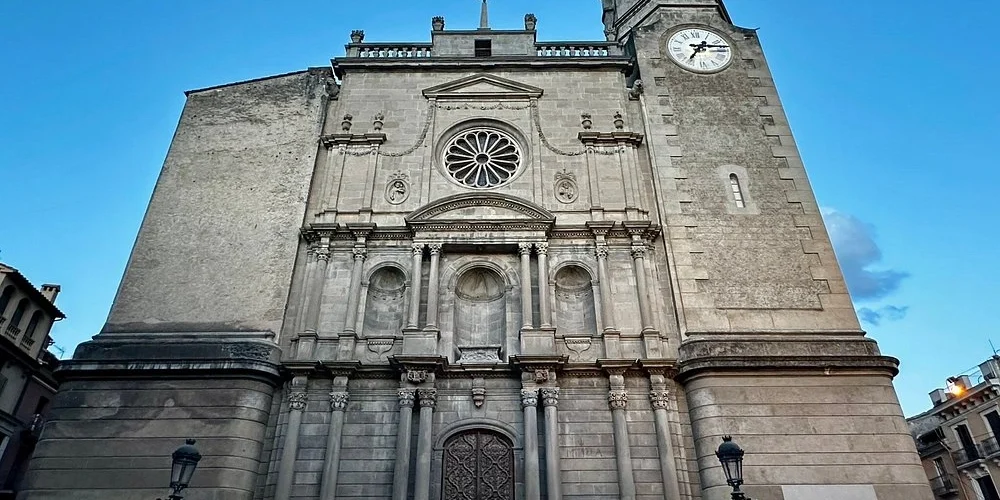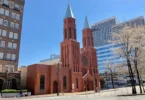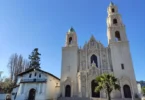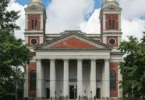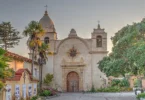Introduction
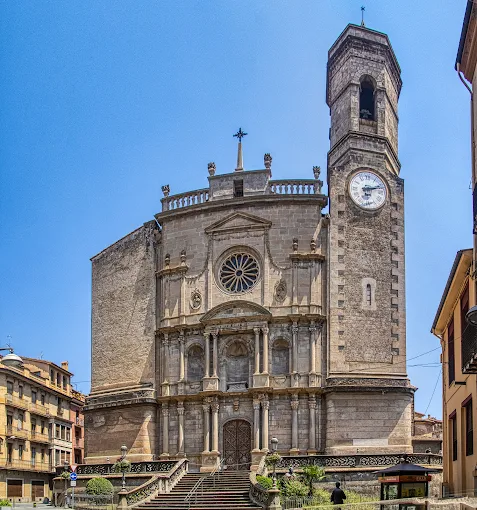
Sant Esteve d’Olot is a prominent parish basilica located in the heart of the city of Olot, within the comarca of La Garrotxa, in the province of Girona, Catalonia, Spain. This significant religious and architectural landmark holds the designation of a Bien Cultural de Interés Nacional (Cultural Asset of National Interest), reflecting its historical, artistic, and cultural importance. With origins dating back to earlier centuries, the current structure is known for its blend of architectural styles and its central role in the spiritual and community life of Olot. The basilica houses notable works of art and has long served as a focal point for religious ceremonies, local traditions, and heritage conservation in the region.

Early Origins and Medieval Foundations
The history of Sant Esteve d’Olot stretches back to the early medieval period, with the first documented reference appearing in the year 846. This record, issued by Carolingian Emperor Charles II the Bald, was addressed to Abbot Racimir of the monastery of Sant Aniol d’Aguges, and mentions a church dedicated to Saint Stephen. This initial structure is believed to have been constructed during the Visigothic era, situated on Puig de Sant Esteve, a volcanic hill on the slopes of the Montsacopa volcano, outside the original walled city of Olot. The church is again mentioned in a 977 document by Count-Bishop Miró Bonfill of Girona, and once more in 1097, when Count Bernat II of Besalú referenced the parrochia Sanct Stephani olotensis in a donation to the monastery of Santa Maria de Ripoll.
Romanesque Reconstruction (12th Century)
In 1116, a significant transformation took place with the construction of a Romanesque church on the same site. The consecration was led by Bishop Berenguer, who noted that the new building was replacing an earlier church already dedicated to Saint Stephen. This Romanesque iteration featured three altars and was similar in scale and design to that of Sant Esteve d’en Bas, reflecting the architectural norms of Catalonia during that period.
Gothic Expansion and Destruction (14th–15th Centuries)
By the 14th century, the growth of Olot prompted another expansion of the church. In 1331, Bishop Gastó de Montcada issued an appeal for funds to support the construction of a grander parish church. By 1357, the Gothic church boasted four consecrated altars, suggesting its increasing liturgical and social importance. However, this structure faced devastation during the earthquakes of 1427, which severely damaged both the church and the town. In the aftermath, a makeshift chapel was erected to continue religious services, a temporary solution that lasted at least until 1432.
War, Urban Integration, and Late Gothic Church (15th–16th Centuries)
During the Remença Wars (1462–1472), the church was repurposed as a fortress to defend the town of Olot. In the late 15th and early 16th centuries, urban development in the area known as Vila Nova, particularly the expansion into the Pia Almoina meadow, helped integrate the parish of Sant Esteve into the growing city. Previously located outside the city walls, the church and its sacristy now became part of the urban landscape. In 1548, construction began on a new late Gothic structure, which expanded on the remnants of earlier buildings. By 1598, the church had grown significantly, containing 15 altars, and serving a town of about 800 homes and 4,000 residents.
18th-Century Transformation: Neoclassical Rebirth
The 18th century marked a turning point for both Olot and Sant Esteve. The town’s population more than doubled, reaching over 9,000 inhabitants by 1787, necessitating a larger church. Between 1750 and 1763, the current Neoclassical basilica was constructed directly over the existing structure, allowing worship to continue throughout the building process. Though the original design included two bell towers, only one was ultimately completed. The project sparked some controversy due to its cost and scope, especially amid the socio-political unrest of the late 18th and 19th centuries.
Architectural Legacy and Chronology
The site of Sant Esteve d’Olot carries a remarkable architectural legacy, having been home to five successive churches, each shaped by the spiritual needs and stylistic influences of its time. The earliest known structure likely dates to the pre-9th century, possibly a Visigothic chapel situated on the volcanic hill known as Puig de Sant Esteve. This was replaced in the 12th century by a Romanesque church featuring three altars, which served the growing medieval community. In the mid-14th century, a Gothic church was erected, but it was tragically destroyed during the catastrophic earthquakes of 1427. Reconstruction efforts in the late 15th and early 16th centuries led to a Late Gothic version of the church, which remained unfinished for decades due to war and financial constraints. Finally, between 1750 and 1763, the current Neoclassical basilica was constructed, enveloping parts of the older structure while introducing a grander, more symmetrical design. This present-day building reflects the Enlightenment-era desire for architectural harmony and monumentality and stands as a testament to centuries of resilience, faith, and cultural evolution in Olot.
Modern Recognition and Cultural Significance
Sant Esteve d’Olot was officially recognized as a National Monument (BCIN) in 1990, reflecting its historical, architectural, and cultural significance. In 2015, the Museum-Treasure of Sant Esteve was inaugurated in the former Chapel of the Immaculate Conception, showcasing a collection of religious art, including paintings, sculptures, liturgical objects, and even a Jewish tombstone dated 1209, underscoring the basilica’s deep historical roots.

Restorations and Revivals (2016–2025)
In 2016, powerful winds damaged one of the bells in the bell tower. This led to a complete replacement of the iron bells—over a century old—with lightweight pressed steel versions, carried out by the Olot City Council, which owns the clock (the church itself remains under the Bishopric of Girona). On December 26, 2019, the traditional “Tocs de Sant Esteve”—manually rung bells for the feast of Saint Stephen—were revived after decades of absence, performed by Xavier Pallàs of the Municipal Music School. In 2020, restoration efforts began on the facade, focusing on preventing water damage to the stonework. A new statue of Saint Stephen, sculpted by Joan Ferrés, was installed. Plans are underway to install companion statues of Saint Sabina and Saint Valentine, created by local artists Manel Traiter and Modest Fluvià, in June 2025, completing the restoration of the basilica’s late Baroque facade.
Elevation to Minor Basilica (2024)
On November 1, 2024, Pope Francis officially granted Sant Esteve d’Olot the prestigious title of Minor Basilica, a designation that acknowledges its enduring religious, historical, and artistic importance within the Catholic Church. This new status strengthens its role as a center of spiritual life and cultural heritage in the Garrotxa region.
Architecture of Basilica of St. Stephen, Olot, Spain

Architectural style : Neoclassical architecture.
Architectural Structure and Layout
The Basilica of Sant Esteve d’Olot is designed in a Latin cross plan, adhering to classical neoclassical principles both in its interior and exterior. The structure features a single nave measuring 58 meters in length and 37.4 meters in width, while the transept spans 52 meters across. Its height reaches 34.5 meters, creating an impressive sense of vertical space and solemnity within the church. Access to the building is provided by three main staircases—one at the entrance and one at each end of the transepts—reinforcing its symmetrical design and ceremonial grandeur.
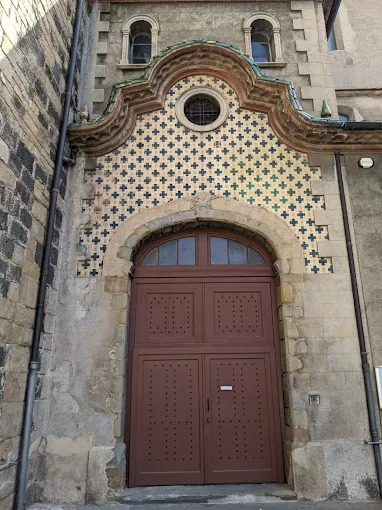
The Neoclassical Facade
The main facade, constructed in 1800, is a key architectural element of the basilica. In 1886, work began to further embellish the facade with an ambitious design that included a central frontispiece flanked by two bell towers, though this plan was never fully completed. The central access staircase is both functional and monumental, composed of eighteen stone steps, arranged in two sections of nine steps each, widening at the base and narrowing toward the top. Decorative iron railings mark the four corners of the staircase, and lantern bases stand at the lower corners. One of the most symbolic features is the “door of the dead” on the south facade. This entrance is framed by a flattened arch decorated with volutes, and its keystone bears the coat of arms of Olot surrounded by stylized foliage.
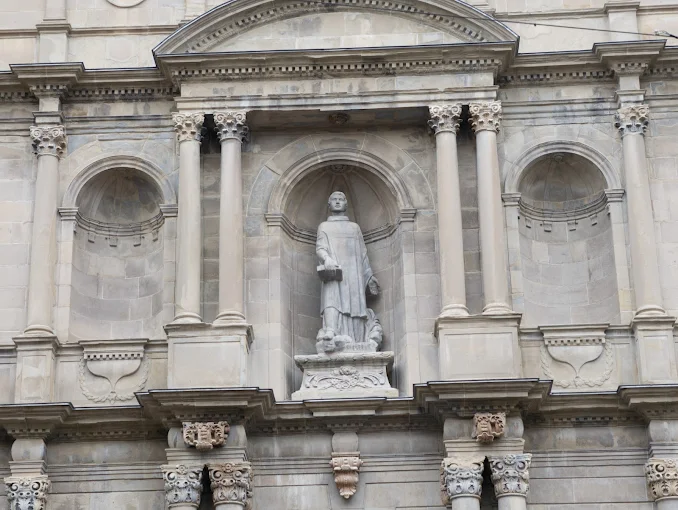
Ornamental Features and Artistic Details
Above the entrance, the upper facade is decorated with glazed ceramic tiles in alternating yellow and blue, and a large oculus with an iron cross motif at its center. The wavy cornice is edged with green glazed tiles and flanked by two pinnacles. Within the entrance archway, a niche houses a figure of Christ, dated 1843, which likely marks the year of the door’s construction. Higher up on the facade are three niches: the central one originally held a statue of Saint Stephen, and the flanking ones contained Saint Valentine and Saint Sabina. These statues were lost during the Spanish Civil War of 1936, though the central figure has since been replaced, and new sculptures for the flanking niches are scheduled for installation in 2025.
Symbolic Sculptural Elements
On the Carrer Major side of the building, three notable keystones are embedded into the vault. These keystones contain deeply symbolic carvings: the first shows two angels bearing a monstrance, representing the Eucharist; the second features a divine hand holding scales, likely alluding to divine justice; and the third depicts a saint playing a musical instrument, symbolizing spiritual harmony and sacred music.
Liturgical Furnishings and Decorative Fonts
The baptismal font is located in a side chapel on the epistle side of the basilica. In addition, six holy water fonts dating from the 18th century are preserved throughout the church. These fonts are richly decorated some with trios of angel heads, others with shell motifs and floral designs—exemplifying the church’s attention to both function and artistic detail.
Medieval Tombstones and Historical Memorials
Three significant tombstones are embedded in the Chapel of the Most Holy Sacrament, dating from 1348 and 1393. Their original placement is unknown, but they were reinstalled during a later reconstruction. These gravestones commemorate Pere Oruga (a priest and deacon), Antoni Costa of Olot, and Pere de Busquets, a priest who served weekly Mass. Two other tombstones from the region—those of Sant Andreu del Coll and Santa Bàrbara de Pruneres—were destroyed during the Civil War, though plaster copies are preserved.
Featured Liturgical Artworks
The basilica houses a rich collection of liturgical artworks, many of which have been designated as part of its Cultural Property of National Interest. Notable among these is the Altarpiece of the Rose Garden, crafted in carved and polychrome wood by Pau Costa between 1704 and 1707. Another masterpiece is the Holy Christ, a polychrome sculpture with goldsmith elements made by Ramon Amadeu i Grau in the early 19th century, who also created the expressive carving of the Angels with Veronica. A series of eight oil paintings by Joan Carles Panyó i Figaró, and his wrought and gilded combregador, also enrich the interior.
Sculptures and Devotional Carvings
Among the notable sculptures is the alabaster statue of Saint Stephen, created in 1949 by acclaimed sculptor Josep Clarà i Ayats. Manuel Cabarrocas contributed an angel holding garlands (1828–1837), while Ramon Amadeu i Grau is credited with a touching Pietà and a carving of Saint Francis of Assisi, both from the 19th to early 20th centuries. A detailed relief of the Virgin of Montserrat, crafted in the 17th–18th century, also enhances the Marian iconography of the church. Other important pieces include the Altarpiece of Saint Joseph (1707–1728) by Pau Costa and others, the Altar of Saint Anthony (1727), and the Tabernacle by Panyó i Figaró (1829), later reproduced between 1947–1948.
Later Additions and Artistic Tributes
In the Chapel of Sorrows, a mid-20th century series of oil paintings by Lluís Carbonell illustrates the Seven Sorrows of the Virgin. In the baptistery, a 19th-century painting of the Baptism of Jesus by Saint John by Melcior Diumenge adds to the spiritual ambiance. Outside, in the parish gardens, stands a sculpture of Rector Esteve Ferrer i Casadevall, created in 1983 by Carmina Gibert, serving as a tribute to one of the church’s most respected clergymen.
The Parish Museum of Sant Esteve d’Olot
Historical Overview
The Parish Museum of Sant Esteve d’Olot is one of the oldest ecclesiastical museums in the Girona region, having first opened its doors to the public in March 1948. It was established to preserve and showcase the artistic and liturgical heritage of the basilica and surrounding parishes. Over the decades, the museum has grown into a key cultural institution, offering insight into the religious, artistic, and social history of the region.

Diverse and Historic Collections of the Parish Museum
The Parish Museum of Sant Esteve d’Olot boasts a diverse and historically rich collection of religious art and artifacts that span several centuries. Among its most notable holdings are intricately crafted goldsmithing objects, including chalices, reliquaries, and other liturgical vessels from various historical periods, alongside paintings by Joan Carles Panyó, a distinguished early 19th-century Catalan artist known for his neoclassical religious works. The museum also preserves a rare medieval tombstone inscribed in Hebrew, offering a unique glimpse into the Jewish history of the region. Other highlights include finely embroidered liturgical vestments, fragments of ancient altarpieces and decorative wooden panels, elements of Olot’s monumental Gothic cross, as well as illuminated choir books featuring Gregorian chant, and an array of religious statues and devotional images once used in parish processions and rituals. In addition to items from Sant Esteve itself, the museum also houses important contributions from neighboring parishes, particularly Sant Cristòfol de les Fonts and Santa Maria de Batet, which expand its narrative to reflect the broader ecclesiastical heritage of La Garrotxa. Among the museum’s most prized works is Christ Embracing the Cross, attributed to El Greco—a powerful and expressive painting that was heroically hidden by a local woman during the Spanish Civil War to protect it from looting. This masterpiece is a cornerstone of the collection, symbolizing both spiritual devotion and communal courage. Additional highlights include the Altarpiece of the Pietà, attributed to Miquel Torell, a noted artist of the late Gothic and early Renaissance, and the partially preserved Altarpiece of Saint Eloi, which features five intricately carved relief panels depicting scenes from the saint’s life, offering further insight into the devotional and artistic traditions of medieval Catalonia.
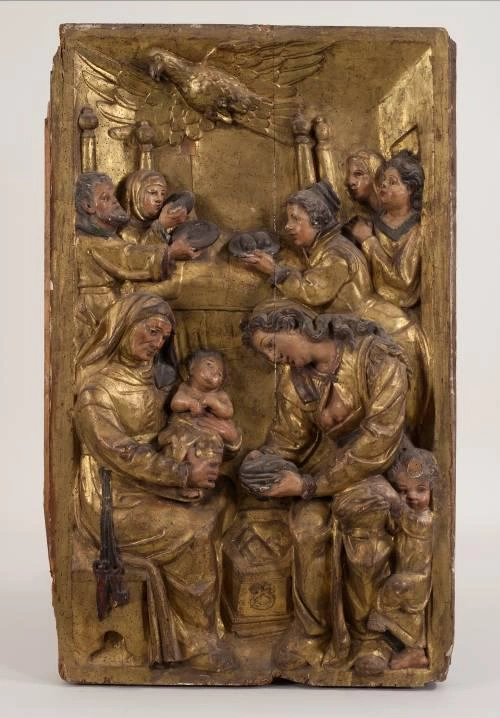
This masterpiece is a cornerstone of the collection, symbolizing both spiritual devotion and communal courage. Additional highlights include the Altarpiece of the Pietà, attributed to Miquel Torell, a noted artist of the late Gothic and early Renaissance, and the partially preserved Altarpiece of Saint Eloi, which features five intricately carved relief panels depicting scenes from the saint’s life, offering further insight into the devotional and artistic traditions of medieval Catalonia.
Current Exhibition Space: The Treasure Museum
Today, the most valuable and best-preserved items from the Parish Museum are displayed in the Treasure Museum (Museu-Tresor), located within the Chapel of the Immaculate Conception in the transept of the basilica. This modern exhibition space was inaugurated in 2015 and offers a thoughtfully curated presentation of the church’s heritage, enhancing both public access and conservation. Through this setting, visitors can engage more deeply with the artistic legacy of Sant Esteve d’Olot in a contemplative and historically meaningful environment.
Feast Day
Feast Day : 26 December
The feast day of Saint Stephen, patron saint of the Basilica of Sant Esteve in Olot, is celebrated on December 26th. This day honors Saint Stephen, the first Christian martyr, with special Masses, prayers, and the traditional ringing of the basilica’s bells known as the “Tocs de Sant Esteve.” The celebration is both a religious and cultural event, reflecting the community’s deep connection to their patron saint and the historic basilica.
Church Mass Timing
Monday to Friday : 10:00 AM
Saturday : 7:00 PM
Sunday : 11:00 AM
Church Opening Time:
Open 24 Hours
Contact Info
Address : Basilica of St. Stephen
Plaça Rector Ferrer, 1, 17800 Olot, Girona, Spain.
Phone : +34972 260 474
Accommodations
Connectivities
Airway
Basilica of St. Stephen, Olot, Spain, to Aeròdrom de Tortellà 17853 Tortellà, distance 18 min (15.8 km) via A-26.
Railway
Basilica of St. Stephen, Olot, Spain, to Girona Plaça d’Espanya, distance between 50 min (55.0 km) via A-26 and C-66.

